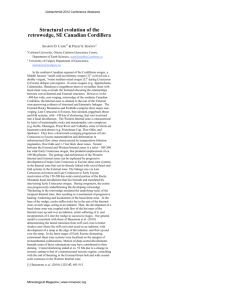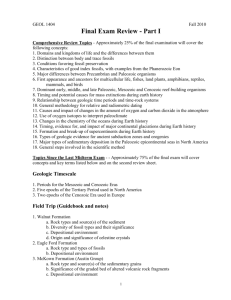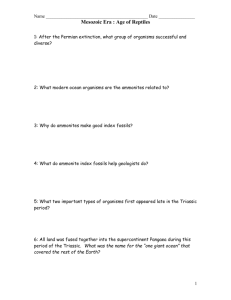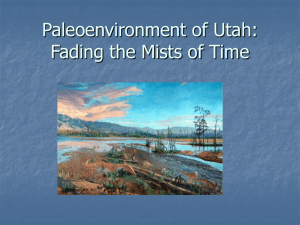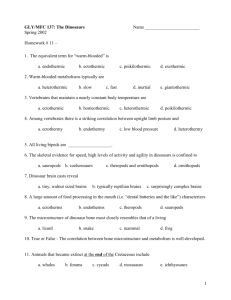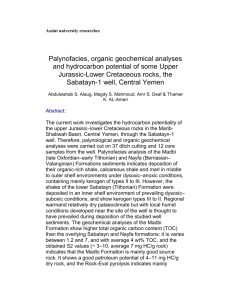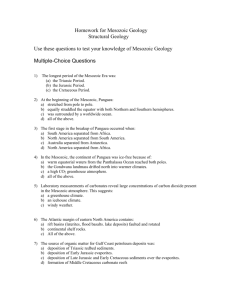Mannion_et_al_Pseudosuchia_SI_Nature_Comms_revised
advertisement
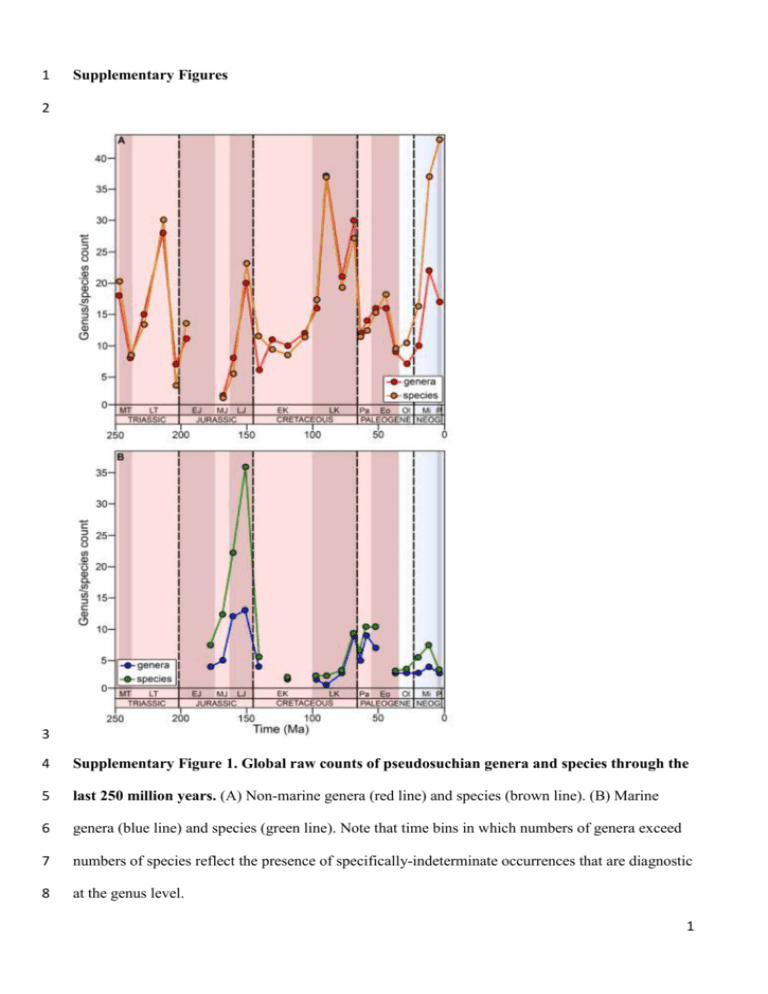
1 Supplementary Figures 2 3 4 Supplementary Figure 1. Global raw counts of pseudosuchian genera and species through the 5 last 250 million years. (A) Non-marine genera (red line) and species (brown line). (B) Marine 6 genera (blue line) and species (green line). Note that time bins in which numbers of genera exceed 7 numbers of species reflect the presence of specifically-indeterminate occurrences that are diagnostic 8 at the genus level. 1 9 10 Supplementary Figure 2. Species to genus count ratios through the last 250 million years, showing 11 no significant trend (full time series: p = 0.019; R2 = 0.1749; time series excluding Neogene: p = 12 0.366; R2 = -0.007). R2 is the adjusted R2 of ordinary least squares regression. 13 14 Supplementary Figure 3. Time bin interval durations used in this study, showing no significant 15 trend of interval duration through time (p = 0.161; R2 = 0.039). 16 2 17 18 19 Supplementary Figure 4. Additional log10-transformed regional subsampling curves for non- 20 marine genera. (A) Early Jurassic (J1) subsampling curves. (B) Late Cretaceous (K7) subsampling 21 curves. (C) Late Cretaceous (K8) subsampling curves. (D) Middle Eocene (Pg3) subsampling 22 curves. (E) Late Eocene (Pg4) subsampling curves. (F) Late Neogene (Ng3) subsampling curves. 23 24 25 Supplementary Figure 5. Palaeolatitudinal distribution of all marine pseudosuchian (blue 26 circles) and all marine tetrapod (black circles) occurrences through time. 3 27 28 29 Supplementary Figure 6. Palaeotemperature and sea level through time. (A) Palaeotemperature 30 (δ18O) plot based on Zachos et al.1 with weighted means (yellow circles). (B) Palaeotemperature 31 (δ18O) plot based on Prokoph et al.2 with weighted means (yellow circles). (C) Sea level (metres) 32 plot based on Miller et al.3 with weighted means (blue circles). 4 33 34 35 36 Supplementary Figure 7. Subsampled marine biodiversity versus extrinsic factors. (A) 37 Biodiversity versus δ18O (from Prokoph et al.2). (B) Biodiversity versus δ18O (from Prokoph et al.2) 38 using first differences. (C) Biodiversity versus sea level44. (D) Biodiversity versus sea level (from 39 Miller et al.3) using first differences. Correlation statistics are only shown for the transformed (first 40 differenced) data series. 41 42 5 43 Supplementary Tables 44 Age of base Abbreviation Time interval Included stages 7.2 Ng3 Late Miocene– Pleistocene Messinian, Zanclean, Piacenzian, Gelasian 16.0 Ng2 Middle–late Miocene Langhian, Serravallian, Tortonian 23.0 Ng1 Early Miocene Aquitanian, Burdigalian 33.9 Pg5 Oligocene Rupelian, Chattian 41.2 Pg4 Late Eocene Bartonian, Priabonian 47.8 Pg3 Middle Eocene Lutetian 56.0 Pg2 Early Eocene Ypresian 61.6 Pg1 Middle–late Paleocene Selandian, Thanetian 66.0 Pg0 Early Paleocene Danian 72.1 K8 Late Cretaceous Maastrichtian 83.6 K7 Late Cretaceous Campanian 93.9 K6 Late Cretaceous Turonian, Coniacian, Santonian 100.5 K5 Late Cretaceous Cenomanian 113.0 K4 Early Cretaceous Albian 126.3 K3 Early Cretaceous Aptian 133.9 K2 Early Cretaceous Hauterivian, Barremian 145.0 K1 Early Cretaceous Berriasian, Valanginian 157.3 J6 Late Jurassic Kimmeridgian, Tithonian 166.1 J5 Middle Jurassic Callovian, Oxfordian 170.3 J4 Middle Jurassic Bajocian, Bathonian 182.7 J3 Early–Middle Jurassic Toarcian, Aalenian 190.8 J2 Early Jurassic Pliensbachian 201.3 J1 Early Jurassic Hettangian, Sinemurian 209.5 Tr5 Late Triassic Rhaetian 228.4 Tr4 Late Triassic Norian 237.0 Tr3 Late Triassic Carnian 241.5 Tr2 Middle Triassic Ladinian 252.2 Tr1 Early–Middle Triassic Induan, Olenekian, Anisian 45 6 46 Supplementary Table 1. Composite, approximately 9 million year time bins used in the 47 present study. Absolute values are given to one decimal place. Abbreviations: Tr=Triassic; 48 J=Jurassic; K=Cretaceous; Pg=Paleogene; Ng=Neogene. 49 Region Included countries North America United States, Canada, Mexico Europe United Kingdom, France, Germany, Italy, Switzerland, Spain, Belgium, Germany, Romania, Sweden, Czech Republic, Denmark, Slovenia, Norway, Luxembourg, Netherlands, Ukraine, Hungary, Austria, Poland, Croatia, Portugal Asia China, Mongolia, South Korea, Russian Federation, North Korea South America Argentina, Chile, Brazil, Bolivia, Colombia, Uruguay, Peru, Venezuela Africa Zambia, Namibia, Zimbabwe, Mali, Angola, Ethiopia, Cameroon, Malawi, Senegal, Tanzania, Eritrea, Sudan, Kenya, Libya, Niger, Tunisia, Algeria, Lesotho, Morocco, South Africa Australasia Australia 50 51 Supplementary Table 2. Countries included in our contiguous continental regions. 52 53 Supplementary Methods 54 55 Modifications to fossil occurrences of extant genera. The database contains numerous fossil 56 occurrences and species referred to extant pseudosuchian genera. Whereas many of these are 57 considered genuine early occurrences of living taxa, others are not. Crocodylus has been 58 hypothesized to have evolved in the late Miocene based on both molecular4–6 and morphological 59 work, including the oldest known fossil occurrences that can be referred to the modern genus7–10. 7 60 Dozens of fossil species have been referred to Crocodylus, but most of these have since been 61 allocated to other genera or are too fragmentary to recognize as valid taxae.g.7,10–13. Five extinct 62 species with fossil records are considered valid and likely to belong to Crocodylus, or are at least 63 close to this radiation: C. anthropophagus, C. checchiai, C. falconensis, C. palaeindicus, and C. 64 thorbjarnarsoni14–16. 65 Six taxa (C. acer, C. affinis, C. clavirostris, C. depressifrons, C. gariepensis, and C. megarhinus) 66 originally described as species of Crocodylus, but no longer considered referable to the genus, are 67 widely regarded as taxonomically distinct7,11,13,14,16,17 but have yet to receive a new name. However, 68 some of these might represent species of existing genera, rather than distinct genera. The North 69 American taxon C. acer has been recovered as the sister taxon to Brachychampsae.g.16 and thus 70 could potentially be included within that genus. However, whereas Brachychampsa is restricted to 71 the Late Cretaceous–early Paleocene of North America, C. acer is known from the early Eocene. As 72 such, there is no temporal overlap between the two, and thus we consider C. acer a distinct genus 73 for the purposes of our analyses, without risk of within-time-bin biodiversity inflation. C. affinis 74 and C. depressifrons are known from the Eocene of North America and Europe respectively, and 75 both have been regarded as closely related to, or even referable to, the basal crocodyloid 76 Asiatosuchuse.g.17. However, whereas C. depressifrons is found in deposits that are spatiotemporally 77 contemporaneous with Asiatosuchus, and thus its inclusion might artefactually inflate European 78 diversity, no North American material has been referred to Asiatosuchus. As such, although C. 79 affinis could potentially belong to Asiatosuchus, consideration of it as a distinct genus will not 80 overinflate our reconstruction of North American biodiversity. C. clavirostris was found in deposits 81 that are approximately contemporaneous with those of Eosuchus minor, and the two might be 82 closely related18, as such, we do not regard C. clavirostris as a distinct genus. C. gariepensis has 83 been recovered in a clade with Mecistops and Euthecodon13, and overlaps geographically and 84 temporally with the latter. Consequently, it could be a species of Euthecodon and accordingly we do 85 not include it as a distinct genus. Lastly, C. megarhinus is recovered near the base of the clade that 8 86 includes extant Crocodylinae (Crocodylus, Mecistops and Osteolaemus), and does not appear 87 referable to any existing genuse.g.16. Therefore, here we regard C. megarhinus as a distinct genus. In 88 summary, we recognize C. acer, C. affinis and C. megarhinus as distinct genera for the purposes of 89 our analyses, and exclude C. clavirostris, C. depressifrons and C. gariepensis. 90 Several putative species of Crocodylus based on fragmentary material have occurrences in the 91 PaleoDB, but lack recorded taxonomic opinion data: we exclude C. blavieri, C. humilis, C. 92 kutchensis, C. proavus, C. selaslophensis and C. vetustus as nomina dubia that do not represent 93 distinct taxa. Based on the proposed timing of the evolution of Crocodylus (see above), we exclude 94 specifically indeterminate pre-late Miocene occurrences referred to this genus (i.e. Crocodylus sp.). 95 A small number of fragmentary occurrences from the Neogene of Africa have been tentatively 96 referred to the extant genera Mecistops and Osteolaemus19,20. Although these assignments might 97 ultimately prove incorrect, they are in keeping with the expected timing of the evolution of these 98 two taxae.g.4, and as such are retained herein. 99 All Alligator species with occurrences in the PaleoDB (the extinct taxa A. luicus, A. mefferdi, A. 100 olseni, A. prenasalis, A. thomsoni, as well as the extant species A. mississippiensis and A. sinensis) 101 are considered valid species of this genus21,22. Paleocene occurrences referred to Alligator23 are 102 excluded because of their fragmentary and non-diagnostic nature. All occurrences of Caiman, 103 Melanosuchus and Paleosuchus in the PaleoDB are restricted to the Neogene and 104 Quaternarye.g.15,21,24–28, and are therefore accepted as valid. 105 Several extinct species of Gavialis, along with specifically indeterminate remains, are known 106 from the Neogene of the Indian subcontinent and southeast Asia29–31. The oldest known occurrence 107 of Gavialis is from the early Miocene of Pakistan32, which is stratigraphically congruent with the 108 ages of closely related taxae.g.33, and with the approximate timing of a proposed split from 109 Tomistoma, according to molecular studiese.g.34,35. As such, we make no changes to Gavialis in our 110 dataset. 9 111 As with other extant crocodylian taxa, numerous fossil species have been assigned to Tomistoma, 112 although several have been allocated to new genera or regarded as non-diagnostic (see Piras et al.36 113 for a review). Currently, relationships within Tomistominae are poorly resolved, especially 114 regarding whether any fossil species can be included in Tomistoma36–38. Whereas most of these 115 putative Tomistoma occurrences are Neogene, and thus in keeping with the proposed timing of the 116 evolution of the genuse.g.35, two species (T. petrolica and T. tandoni) have been described from 117 Eocene deposits36. As some of these species are likely distinctive taxa (e.g. T. cairense, T. 118 lusitanicum, T. petrolica), even if not referable to Tomistoma36,38, and the group is in need of 119 detailed taxonomic revision, we do not exclude any occurrences currently referred to Tomistoma 120 from our analyses. 121 122 Cretaceous thalattosuchians. Thalattosuchia has been the subject of numerous recent taxonomic 123 revisionse.g.39–43, resulting in the recognition of only five genera unambiguously present in the 124 Cretaceous. Cricosaurus is known from remains from the Berriasian of Argentina and the 125 Valanginian of western Europe40, including material originally referred to ‘Enaliosuchus’ and 126 Geosaurus43. Two Berriasian Argentinean localities have yielded remains of Dakosaurus44. 127 Geosaurus and Neustosaurus are present in the Valanginian–Hauterivian of France43. Peipehsuchus 128 was identified as a thalattosuchian42 and is known from the Tzeliuching Formation of China, but the 129 age of this stratigraphic unit cannot currently be constrained more accurately than Early Cretaceous. 130 Numerous Early Cretaceous remains have been referred to Machimosaurus, but all of these have 131 either been refuted, or their affinities remain uncertain41. Late Cretaceous referrals from Sudan45 132 and Brazil46 are fragmentary and their affinities remain unsubstantiated. An occurrence of the 133 otherwise Jurassic taxon Teleosaurus is apparently present in the Valanginian of the UK47, but this 134 specimen does not seem to have been mentioned in the recent literature, including recent reviews of 135 the UK fossil recorde.g.48,49, and its affinities remain unclear. Consequently, we restrict 10 136 Machimosaurus and Teleosaurus to the Jurassic, in keeping with the view that teleosauroids went 137 extinct at the Jurassic/Cretaceous boundary40,50. 138 139 Time-binning scheme. Our scheme of time bins comprises approximate 9 myr bins following the 140 Standard European stages and absolute dates provided by Gradstein et al.51, and is shown in 141 Supplementary Table 1. Occurrences were assigned to a time bin only if their stratigraphic age 142 uncertainty was entirely contained within that bin. The exception to this is pseudosuchian 143 occurrences from the Brazilian Late Cretaceous Adamantina Formation. Currently, fifteen 144 pseudosuchian genera (all belonging to Notosuchia, with several taxa represented by multiple 145 occurrences) are known from this stratigraphic unit, which was deposited at subtropical 146 palaeolatitudes ranging from 24–28°S52,53. However, there is little consensus on the age of the 147 formation53, with some authors proposing a Turonian–Santonian age, based on ostracods54, whereas 148 other have argued for a Campanian–Maastrichtian age, based on vertebrate fossilse.g.55,56. As a result 149 of the high biodiversity of this formation, coupled with its geographical position, we incorporate the 150 Adamantina Formation and its constituent pseudosuchian taxa into our analyses by arbitrarily 151 assigning it to our K6 (Turonian, Coniacian, Santonian) time bin (see Supplementary Table 1), on 152 the basis that the ostracod data54 is more likely to be a reliable indicator of its age. 153 154 Spatial-binning scheme. Continental regions were selected by targeting contiguous, well-sampled 155 areas of approximately comparable geographic spread (Supplementary Table 2). For example, 156 although peripheral sub-regions such as Cuba and Greenland are technically parts of North America 157 by cartographical conventions, they are geographically distant to, and poorly sampled compared to, 158 the core regions of North America (United States, Canada, Mexico). Including these peripheral 159 regions has the effect of adding a small number of occurrences of primarily singleton taxa to the 160 sampling pool of North America. The addition of singletons causes the core region to appear less 161 well sampled than in fact it is, and thereby inflates subsampled diversity estimates. A similar 11 162 protocol was used for other regions, e.g. Japan and southern Asian countries were excluded from 163 our Asian region. 164 165 Supplementary References 166 167 168 169 1. Zachos, J. C., Dickens, G. R. & Zeebe, R. E. An early Cenozoic perspective on greenhouse warming and carbon-cycle dynamics. Nature 451, 279–283 (2008). 2. Prokoph, A., Shields, GA & Veizer, J. Compilation and time-series analysis of a marine 170 carbonate δ18O, δ13C, 87Sr/86Sr and δ34S database through Earth history. Earth-Sci. Rev. 87, 113– 171 133 (2008). 172 173 174 175 176 3. Miller, K. G. et al. The Phanerozoic record of global sea level change. Science 310, 1293–1297 (2005). 4. Oaks, J. R. A time-calibrated species tree of Crocodylia reveals a recent radiation of true crocodiles. Evolution 65, 3285–3297 (2011). 5. Meganathan, P. R., Dubey, B., Batzer, M. A., Ray, D. A. & Haque, I. Molecular phylogenetic 177 analyses of genus Crocodylus (Eusuchia, Crocodylia, Crocodylidae) and the taxonomic position 178 of Crocodylus porosus. Mol. Phylogenet. Evol. 57, 393–402 (2010). 179 6. Meredith, R. W., Hekkala, E. R., Amato, G. & Gatesy, J. A phylogenetic hypothesis for 180 Crocodylus (Crocodylia) based on mitochondrial DNA: evidence for a trans-Atlantic voyage 181 from Africa to the New World. Mol. Phylogenet. Evol. 60, 183–191 (2011). 182 183 184 185 186 187 7. Brochu, C. A. Phylogenetic relationships and divergence timing of Crocodylus based on morphology and the fossil record. Copeia 2000, 657–673 (2000). 8. Storrs, G. W. in Lothagam: The Dawn of Humanity in Eastern Africa (eds Leakey, M. G. & Harris, J. M. (eds.) 137–159 (Columbia Univ. Press, 2003). 9. Delfino, M., Böhme, M. & Rook, L. First European evidence for transcontinental dispersal of Crocodylus (late Neogene of southern Italy). Zool. J. Linn. Soc. 149, 293–307 (2007). 12 188 189 190 191 10. Delfino, M. & Rook, L. African crocodylians in the Late Neogene of Europe: a revision of Crocodylus bambolii Ristori, 1890. J. Paleontol. 82, 336–343 (2008). 11. Norell, M. A. & Storrs, G. W. Catalogue and review of the type fossil crocodilians in the Yale Peabody Museum. Postilla 203, 1–28 (1989). 192 12. Brochu, C. A. Morphology, relationships, and biogeographical significance of an extinct horned 193 crocodile (Crocodylia, Crocodylidae) from the Quaternary of Madagascar. Zool. J. Linn. Soc. 194 150, 835–863 (2007). 195 196 13. Conrad, J. L. et al. New specimens of ‘Crocodylus’ pigotti (Crocodylidae) from Rusinga Island, Kenya, and generic reallocation of the species. J. Vertebr. Paleontol. 33, 629–646 (2013). 197 14. Brochu, C. A., Njau, J., Blumenschine, R. J. & Densmore, L. D. A new horned crocodile from 198 the Plio-Pleistocene hominid sites at Olduvai Gorge, Tanzania. PLoS ONE 5, e9333 (2010). 199 200 201 15. Scheyer, T. M. et al. Crocodylian diversity peak and extinction in the late Cenozoic of the northern Neotropics. Nat. Commun. 4, 1907 (2013). 16. Brochu, C. A. & Storrs, G. W. A giant crocodile from the Plio-Pleistocene of Kenya, the 202 phylogenetic relationships of Neogene African crocodylines, and the antiquity of Crocodylus in 203 Africa. J. Vertebr. Paleontol. 32, 587–602 (2012). 204 17. Delfino, M. & Smith, T. A reassessment of the morphology and taxonomic status of 205 ‘Crocodylus’ depressifrons Blainville, 1855 (Crocodylia, Crocodyloidea) based on the Early 206 Eocene remains from Belgium. Zool. J. Linn. Soc. 156, 140–167 (2009). 207 18. Brochu, C. A. Osteology and phylogenetic significance of Eosuchus minor (Marsh, 1870) new 208 combination, a longirostrine crocodylian from the late Paleocene of North America. J. Paleontol. 209 80, 162–186 (2006). 210 211 19. Aoki, R. Fossil crocodilians from the late Tertiary strata in the Sinda Basin, eastern Zaire. African Study Monographs 17, 67–85 (1992). 13 212 20. Pickford, M. in Geology and Palaeobiology of the Albertine Rift Valley, Uganda−Zaire, Vol. II, 213 Palaeobiology (eds Senut, B. & Pickford, M.) 137–155 (Centre International pour la formation et 214 les échanges Géologiques (CIFEG), Orleans, Occasional Publications, 1994). 215 216 217 218 219 220 221 21. Brochu, C. A. Phylogenetics, taxonomy, and historical biogeography of Alligatoroidea. J. Vertebr. Paleontol. 19, 9–100 (1999). 22. Snyder, D. Morphology and systematics of two Miocene alligators from Florida, with a discussion of alligator biogeography. J. Paleontol. 81, 917–928 (2007). 23. Erickson, B. R. Crocodilians of the Black Mingo Group (Paleocene) of the South Carolina Coastal Plain. T. Am. Philol. Assoc. 88, 196–214 (1998). 24. Salas-Gismondi R. et al. A Miocene hyperdiverse crocodylian community reveals peculiar 222 trophic dynamics in proto-Amazonian mega-wetlands. Proc. R. Soc. Lond. Ser. B 282, 20142490 223 (2015). 224 225 226 227 228 229 230 231 25. Medina, C. J. Crocodilians from the Late Tertiary of northwestern Venezuela: Melanosuchus fisheri sp. nov. Breviora 438, 1–14 (1976). 26. Salas-Gismondi, R. et al. Middle Miocene crocodiles from the Fitzcarrald Arch, Amazonian Peru. Cuadernos del Museo Geominero 8, 355–360 (2007). 27. Bona, P. & Carabajal, A. P. Caiman gasparinae sp. nov., a huge alligatorid (Caimaninae) from the late Miocene of Paraná, Argentina. Alcheringa 37, 462–473 (2013). 28. Fortier, D. C. & Rincón, A. D. Pleistocene crocodylians from Venezuela, and the description of a new species of Caiman. Quatern. Int. 305, 141–148 (2013). 232 29. Lull, R. S. Fossil gavials from North India. Am. J. Sci. 242, 417–430 (1944). 233 30. Delfino, M. & de Vos, J. A revision of the Dubois crocodylians, Gavialis bengawanicus and 234 Crocodylus ossifragus, from the Pleistocene Homo erectus beds of Java. J. Vertebr. Paleontol. 235 30, 427–441 (2010). 14 236 31. Martin, J. E., Buffetaut, E., Naksri, W., Lauprasert, K. & Claude, J. Gavialis from the 237 Pleistocene of Thailand and its relevance for drainage connections from India to Java. PLoS ONE 238 7, e44541 (2012). 239 240 32. Piras, P. & Kotsakis, T. A new gavialid from the Early Miocene of south-eastern Pakistan (Preliminary Report). Rendiconti Societa Paleontologica Italiana 2, 201–207 (2005). 241 33. Vélez-Juarbe, J., Brochu, C. A. & Santos, H. A gharial from the Oligocene of Puerto Rico: 242 transoceanic dispersal in the history of a non-marine reptile. Proc. R. Soc. Lond. Ser. B 274, 243 1245–1254 (2007). 244 34. Janke, A., Gullberg, A., Hughes, S., Aggarwal, R. K. & Arnason, U. Mitogenomic analyses 245 place the gharial (Gavialis gangeticus) on the crocodile tree and provide pre-K/T divergence 246 times for most crocodilians. J. Mol. Evol. 61, 620–626 (2005). 247 35. Willis, R. E., McAliley, L. R., Neeley, E. D. & Densmore III, L. D. Evidence for placing the 248 false gharial (Tomistoma schlegelii) into the family Gavialidae: Inferences from nuclear gene 249 sequences. Mol. Phylogenet. Evol. 43, 787–794 (2007). 250 36. Piras, P., Delfino, M., Favero, L. & Kotsakis, T. Phylogenetic position of the crocodylian 251 Megadontosuchus arduini and tomistomine palaeobiogeography. Acta Palaeontol. Pol. 52, 315– 252 328 (2007). 253 37. Kobayashi, Y., Tomida, Y., Kamei, T. & Eguchi, T. Anatomy of a Japanese tomistomine 254 crocodylian, Toyotamaphimeia machikanensis (Kamei et Matsumoto, 1965) from the Middle 255 Pleistocene of Osaka prefecture: the reassessment of its phylogenetic status within Crocodylia. 256 National Science Museum Monograph 35, 1–121 (2006). 257 258 259 38. Brochu, C. A. Systematics and taxonomy of Eocene tomistomine crocodylians from Britain and northern Europe. Palaeontology 50, 917–928 (2007). 39. Pierce, S. E., Angielczyk, K. D. & Rayfield, E. J. Morphospace occupation in thalattosuchian 260 crocodylomorphs: skull shape variation, species delineation and temporal patterns. 261 Palaeontology 52, 1057–1097 (2009). 15 262 40. Young, M. T., Andrade, M. B., Cornée, J.-J., Steel, L. & Foffa, D. Re-description of a putative 263 Early Cretaceous "teleosaurid" from France, with implications for the survival of 264 metriorhynchids and teleosaurids across the Jurassic-Cretaceous Boundary. Annales de 265 Paléontologie 100, 165–174 (2014). 266 267 268 269 270 41. Young, M. T. et al. Revision of the Late Jurassic teleosaurid genus Machimosaurus (Crocodylomorpha, Thalattosuchia). R. Soc. Open Sci. 1, 140222 (2014). 42. Jouve, S. The skull of Teleosaurus cadomensis (Crocodylomorpha; Thalattosuchia), and phylogenetic analysis of Thalattosuchia. J. Vertebr. Paleontol. 29, 88–102 (2009). 43. Young, M. T. & Andrade, M. B. What is Geosaurus? Redescription of Geosaurus giganteus 271 (Thalattosuchia: Metriorhynchidae) from the Upper Jurassic of Bayern, Germany. Zool. J. Linn. 272 Soc. 157, 551–585 (2009). 273 274 275 276 277 278 279 280 44. Gasparini, Z., Pol, D. & Spalletti, L. A. An unusual marine crocodyliform from the JurassicCretaceous boundary of Patagonia. Science 311, 70–73 (2006). 45. Werner, C. Die kontinentale Wirbeltierfauna aus der unteren Oberkreide des Sudan (Wadi Milk Formation). Berliner Geowissenschaften Abhandlungen, Reihe E 13, 221–249 (1994). 46. Huene, F, von. Verschiedene mesozoische Wirbeltierreste aus Südamerika. Neues Jahrbuch für Mineralogie, Geologie und Paläontologie, Abteilung A 66, 181–198 (1931). 47. Etheridge, R. Manual of Geology: Theoretical and Practical. Part II. Stratigraphical Geology and Palaeontology (Charles Griffin & Co., 1885). 281 48. Benton, M. J. & Spencer, P. S. Fossil Reptiles of Great Britain (Chapman & Hall, 1995). 282 49. Salisbury, S. W. & Naish, D. in English Wealden Fossils (ed Batten D. J.) 305–369 283 284 285 286 (Palaeontological Association, London, Field Guide to Fossils, 2011). 50. Martin, J. E., Amiot, R., Lécuyer, C. & Benton, M. J. Sea surface temperature contributes to marine crocodylomorph evolution. Nat. Commun. 5, 4658 (2014). 51. Gradstein, F. M et al. The Geologic Time Scale 2012 (Elsevier, 2012). 16 287 52. Carvalho, I. S., Gasparini, Z. B., Salgado, L., de Vasconcellos, F. M. & Marinho, T. S. 288 Climate’s role in the distribution of the Cretaceous terrestrial Crocodyliformes throughout 289 Gondwana. Palaeogeogr. Palaeoclimatol. Palaeoecol. 297, 252–262 (2010). 290 291 53. Pol, D. et al. A new notosuchian from the Late Cretaceous of Brazil and the phylogeny of advanced notosuchians. PLoS ONE 9, e93105 (2014). 292 54. Dias-Brito, D. et al. Grupo Bauru: uma unidade continental do Cretáceo no Brasil—concepções 293 baseadas em dados micropaleontológicos, isotópicos e estratigráficos. Revue de Paleobiologie 294 20, 245–304 (2001). 295 55. Gobbo-Rodrigues, S. R., Petri, S. & Bertini, R.J. Ocorrências de ostrácodes na Formação 296 Adamantina do Grupo Bauru, Cretáceo Superior da Bacia do Paraná e possibilidades de 297 correlação com depósitos isócronos Argentinos. Parte I—Família Ilyocyprididae. Acta Geológica 298 Leopoldensia 23, 3–13 (1999). 299 300 56. Fernandes, L. A. & Coimbra, A. M. Revisão estratigráfica da parte oriental da Bacia Bauru (Neocretáceo). Revista Brasileira de Geociências 30, 717–728 (2000). 17
